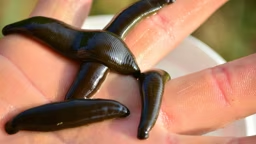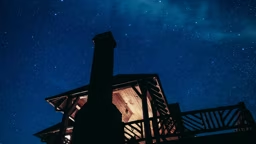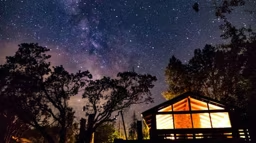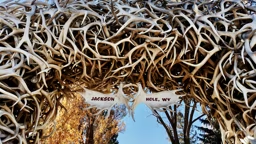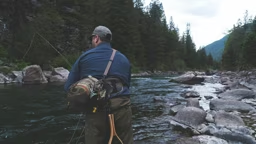A golden, rising sun had just set the lake’s fog aglow. Through the mist a cow moose and her calf swam behind a small, rocky island, making gentle ripples on dark, placid waters. As they came out from the other side and headed for shore, I could hear their labored breathing.
They stood in knee-deep water, pausing before disappearing into the thick, green conifers. Mere minutes later, another moose and her calf appeared just a hundred yards away, walking out into shallow water. They were busy, loud and hungry.
Finally, the good mother led her calf out of the water and into the swamp alders. Now only 30 yards away, they were invisible and silent. Two giants so close yet strangely hidden, I began to wonder how many moose I had missed before, how many Ice Age giants I had paddled by or hiked past, completely oblivious.
They stood in knee-deep water, pausing before disappearing into the thick, green conifers. Mere minutes later, another moose and her calf appeared just a hundred yards away, walking out into shallow water. They were busy, loud and hungry.
Finally, the good mother led her calf out of the water and into the swamp alders. Now only 30 yards away, they were invisible and silent. Two giants so close yet strangely hidden, I began to wonder how many moose I had missed before, how many Ice Age giants I had paddled by or hiked past, completely oblivious.
Meet Mr. Moose
Mention a moose, and people immediately picture the bull moose with flat, multi-pronged antlers. As those antlers suggest, moose are members of the deer family. As with all cervids, they have cloven hooves. And – similar to cows – they are ruminants, relying on bacteria and repeated chewing of cud for digestion. Six feet tall at the shoulder, moose are bigger than horses and the largest of the deer family. Cow moose weigh in at about 700 pounds and big bulls can climb to more than 1,500 pounds.
To see a moose emerge from deep water and climb to shore is to discover how amazingly gangly and long its legs are. A moose trotting along a forest road gives the impression that, at any time, it could lose control of its flailing limbs. In their own habitat, moose are very graceful, masters of a diverse world of lakes and wetlands, soggy meadows and even forested ridges.
Mention a moose, and people immediately picture the bull moose with flat, multi-pronged antlers. As those antlers suggest, moose are members of the deer family. As with all cervids, they have cloven hooves. And – similar to cows – they are ruminants, relying on bacteria and repeated chewing of cud for digestion. Six feet tall at the shoulder, moose are bigger than horses and the largest of the deer family. Cow moose weigh in at about 700 pounds and big bulls can climb to more than 1,500 pounds.
To see a moose emerge from deep water and climb to shore is to discover how amazingly gangly and long its legs are. A moose trotting along a forest road gives the impression that, at any time, it could lose control of its flailing limbs. In their own habitat, moose are very graceful, masters of a diverse world of lakes and wetlands, soggy meadows and even forested ridges.
True Water Lovers
Moose are excellent swimmers, and will often search for food in knee-deep water. Early summer is a time of growth and bodily restoration, and moose seek to replenish valuable salts by foraging for submerged aquatic plants. Occasionally, when foraging in deep water, a moose will completely submerge, with only its head returning above the surface of the water for an occasional breath of air and a good round of chewing.
When feeding in the water, moose are more easily observed, active and even noisy. Clip-clopping and splashing sounds accompany moose as they forage on open lake flats and shallow rivers. And actively feeding moose may cough and blow bubbles.
Water serves double duty in both cooling moose and ridding them of insect pests, so moose often greet the water enthusiastically. I have observed them playing in water with as much joy and zeal as Labrador retrievers, with one cow even chasing a family of ducks back and forth through the shallows of a river.
The Big, Strong Vegetarian
Gentle vegetarians, moose are very fond of maple, birch, aspen and other woody plants. Around the Great Lakes, mountain maple has been likened to “candy” for the moose. When eating summer foliage, moose strip leaves from branches using flexible lips. Twigs are consumed year round and constitute the bulk of winter food.
Often loners, moose will engage in social behavior and can even be quite vocal, uttering plaintive, moaning calls. Cows can be very protective of their young, and bulls may become more aggressive when in their breeding season.
An excellent sense of smell and big ears allow moose to be well aware of their surroundings, but poorer eyesight and fickle winds may create uncertain and even dangerous situations. A worried moose will sometimes give a breathy, flapping huff, a warning worth listening to. Moose are fast and agile when they need to be. Giving a moose plenty of room is a wise move.
The moose is an amazing animal with a rich and complicated life history. In moose range, forest ecology is vividly tied to the lives of these giant herbivores. Each moose, by the sheer volume of food it requires, plays a tremendous role in changing the very shape of the forest.
As the form and function of so many ecosystems on planet Earth change, we must stop to think about one of the last surviving Ice Age relics. Will they survive for future generations? And if we lose them, what could possibly fill the ecological void? Even if the forest could somehow survive their loss, our own sense of loss would be tremendous. So if you are fortunate enough to catch a glimpse of a moose in the wild, you are fortunate indeed.
Brian M. Collins enjoys watching moose in Northern Minnesota, Wyoming, Montana and Canada. He has a Bachelor of Science in Wildlife and Fisheries from the University of Minnesota, a state pretty smitten with the moose!
Moose are excellent swimmers, and will often search for food in knee-deep water. Early summer is a time of growth and bodily restoration, and moose seek to replenish valuable salts by foraging for submerged aquatic plants. Occasionally, when foraging in deep water, a moose will completely submerge, with only its head returning above the surface of the water for an occasional breath of air and a good round of chewing.
When feeding in the water, moose are more easily observed, active and even noisy. Clip-clopping and splashing sounds accompany moose as they forage on open lake flats and shallow rivers. And actively feeding moose may cough and blow bubbles.
Water serves double duty in both cooling moose and ridding them of insect pests, so moose often greet the water enthusiastically. I have observed them playing in water with as much joy and zeal as Labrador retrievers, with one cow even chasing a family of ducks back and forth through the shallows of a river.
The Big, Strong Vegetarian
Gentle vegetarians, moose are very fond of maple, birch, aspen and other woody plants. Around the Great Lakes, mountain maple has been likened to “candy” for the moose. When eating summer foliage, moose strip leaves from branches using flexible lips. Twigs are consumed year round and constitute the bulk of winter food.
Often loners, moose will engage in social behavior and can even be quite vocal, uttering plaintive, moaning calls. Cows can be very protective of their young, and bulls may become more aggressive when in their breeding season.
An excellent sense of smell and big ears allow moose to be well aware of their surroundings, but poorer eyesight and fickle winds may create uncertain and even dangerous situations. A worried moose will sometimes give a breathy, flapping huff, a warning worth listening to. Moose are fast and agile when they need to be. Giving a moose plenty of room is a wise move.
The moose is an amazing animal with a rich and complicated life history. In moose range, forest ecology is vividly tied to the lives of these giant herbivores. Each moose, by the sheer volume of food it requires, plays a tremendous role in changing the very shape of the forest.
As the form and function of so many ecosystems on planet Earth change, we must stop to think about one of the last surviving Ice Age relics. Will they survive for future generations? And if we lose them, what could possibly fill the ecological void? Even if the forest could somehow survive their loss, our own sense of loss would be tremendous. So if you are fortunate enough to catch a glimpse of a moose in the wild, you are fortunate indeed.
Brian M. Collins enjoys watching moose in Northern Minnesota, Wyoming, Montana and Canada. He has a Bachelor of Science in Wildlife and Fisheries from the University of Minnesota, a state pretty smitten with the moose!
Vanishing Act?
Considered a biological mystery, the precipitous decline in the Midwestern moose population is being studied by scientists in the hopes of zeroing in on the true causes. Here are a few likely factors.
Moose are supremely adapted to cold winters, and mild winters can result in many stressors. Their black coat, so perfect in absorbing the warming sun, is also a coat of insulating, hollow hairs and can result in heat stress when conditions are warm.
Less available snow cover can increase the life expectancy of a primary moose parasite, the winter tick. When conditions do get harshly cold, a moose that has failed to dedicate itself to nutrition in the heat and that has rubbed a hole in its hollow-hair insulation due to tick infestation may succumb to the bitter weather.
Warming climates also assist white-tailed deer in their quest for available habitats in the north, and they bring with them a parasitic brain worm that has a more lethal effect on moose than it does on deer.
Reader Resource: www.dnr.state.mn.us.
Considered a biological mystery, the precipitous decline in the Midwestern moose population is being studied by scientists in the hopes of zeroing in on the true causes. Here are a few likely factors.
Moose are supremely adapted to cold winters, and mild winters can result in many stressors. Their black coat, so perfect in absorbing the warming sun, is also a coat of insulating, hollow hairs and can result in heat stress when conditions are warm.
Less available snow cover can increase the life expectancy of a primary moose parasite, the winter tick. When conditions do get harshly cold, a moose that has failed to dedicate itself to nutrition in the heat and that has rubbed a hole in its hollow-hair insulation due to tick infestation may succumb to the bitter weather.
Warming climates also assist white-tailed deer in their quest for available habitats in the north, and they bring with them a parasitic brain worm that has a more lethal effect on moose than it does on deer.
Reader Resource: www.dnr.state.mn.us.
Moose by the #’s
A quick snapshot of how moose populations are faring nationwide:
Maine:
Holding steady at approximately 30,000.
Minnesota:
Populations continue to decline
to a new low of 5,500.
New York:
Increasing from approximately
50 in 1999 to nearly 1,000 today.
Washington:
Slowly increasing from 60 in the 1970s to over 1,000 today.
A quick snapshot of how moose populations are faring nationwide:
Maine:
Holding steady at approximately 30,000.
Minnesota:
Populations continue to decline
to a new low of 5,500.
New York:
Increasing from approximately
50 in 1999 to nearly 1,000 today.
Washington:
Slowly increasing from 60 in the 1970s to over 1,000 today.
 Brian M. Collins
Brian M. Collins 





